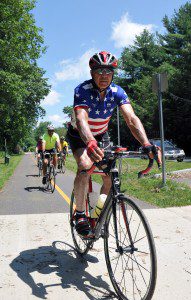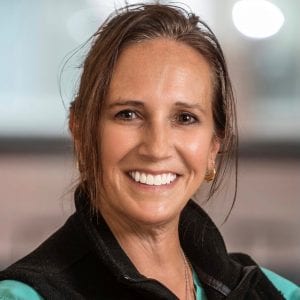
Charles Beristain, dressed in his red, white and blue patriotic ride attire, leads a group of riders on the Southwick Rails-to-Trails linear park. (File photo by chief photographer Frederick Gore)
NORTHAMPTON – Attendees at a “Bikeable Communities” training session offered by Massbike received information on bicycling advocacy – topics ranging from who to contact to suggest a potential project, to how to engage decision-makers and the public, and how to keep up momentum for a project.
Although the ten attendees at the Saturday afternoon session met at the Forbes Library in Northampton, the information had particular relevance to residents of towns such as Southampton, Westfield, and Southwick.
Southampton Trail Progresses
Though Southampton residents voted against two rail trail proposals in the 1990s, a renewed effort underway since then is gaining more momentum. In October 2011 the town Select Board accepted a Greenway Feasibility Study created by the Pare Group of Foxboro, Mass.; and established a Greenway Committee the next month. According to a letter by Michael Buehler, chair of the Southampton Greenway Committee, to the Massbike Pioneer Valley email list, the committee is charged with acquisition and design of a trail along an abandoned railroad corridor that extends from the end of the Manhan Rail Trail at Coleman Road to the intersection of Route 10 and Brickyard Road.
“Probably the single biggest factor putting ‘wind in our sails’ is the completion of the Manhan Trail to Coleman Road – now it seems that lots of Southampton residents are riding that trail and wondering why we don’t have our own,” Buehler added in his letter.
Trail Beginning in Westfield
In Westfield, efforts of bicycle activists that began in the late 1980s finally came to fruition this year as construction began on the first portion of the Columbia Greenway Rail Trail.
“Initially I became interested in the idea of a rail trail when the first public hearings began for the Great River Bridge project, and I realized that the viaduct would make the route useless to the railroad,” said Don Podolski of Westfield, Director of Education and Research for the nonprofit bicycle advocacy group the Friends of the Columbia Greenway.
Along the route since then, Westfield published both a city master plan in 1988 and an open space plan in 1994 that suggested the addition of a rail trail. In 2000, a $250,000 grant kick started the design process for the trail. Around the time of the first public hearing in 2006, a developer tried to sell a portion of the proposed trail for commercial development (an efforts that was ultimately foiled by the efforts of bicycle advocates in Westfield). From that challenging moment, Podolski said, the most powerful impetus for progress was getting local political power behind the trail.
“In 2009 we had a meeting with the two mayoral candidates on the greenway, and both pledged support to finishing the project. When Daniel Knapik won, it was the first time we had a mayor behind the project. That was the key really,” Podolski noted.
“Now we are on a number of budgets, we are on the Pioneer Valley Planning Commission’s Transportation Improvement Plan (TIP) for 2014…and on the TIP for 2016. The most important element is being on the TIP,” added Podolski.
Successful Advocacy in Southwick
Bill Bourque, a Southwick resident who attended the “Bikeable Communities” session, reflected on the impact of successful bicycle advocacy–“The Jog” the town’s recently completed rail trail.
“It’s bringing more people together to exercise and bike together,” he said. “There are a lot more bikers in town. Drivers are more cautious about looking for them,” he added.
Though the trail is successful in Southwick, Bourque said he could envision improvement projects, including training for bicyclists on how to cross intersections with busy roads, and new caution lights at the intersection of the trail and Route 168.
Whatever the challenges of a particular project or community Price Armstrong and Samantha Markowitz of Massbike, who led the training session, stressed the importance of beginning efforts by working with municipal officials; maintaining a respectful, calm, and measured tone in all public interactions as a bicycle activist; and staying engaged as a bicycle project stretches out over time.
As activists in the communities in the Pioneer Valley advocate successfully for better bicycle infrastructure, the momentum will continue to build.
“Whenever a trail progresses to a community, interest always increases in the adjacent community,” Podolski notes.







